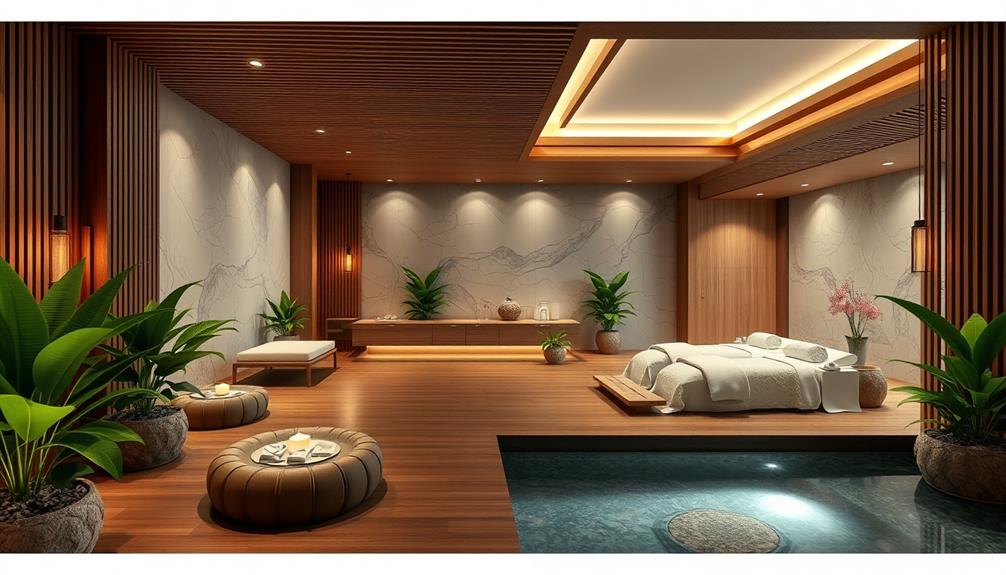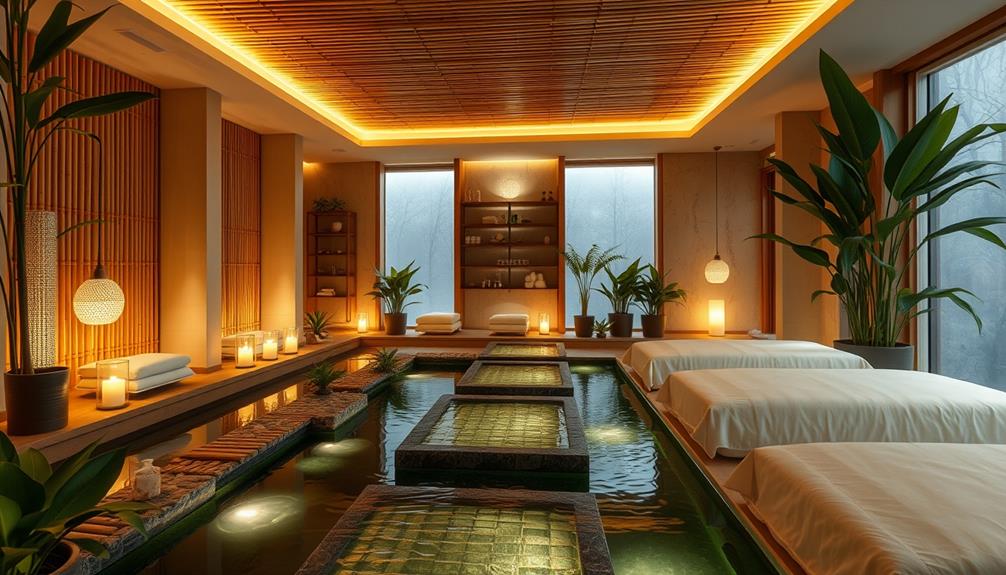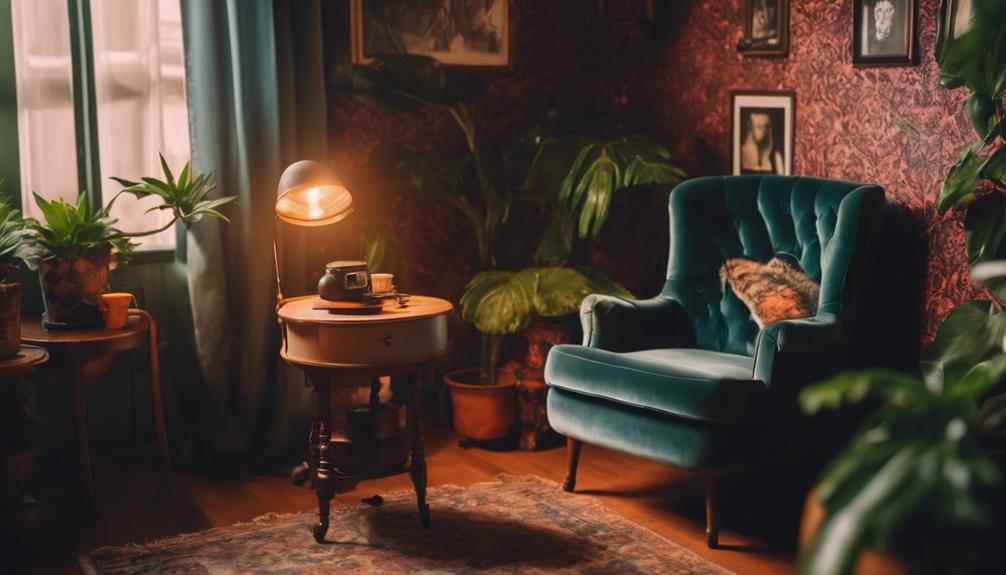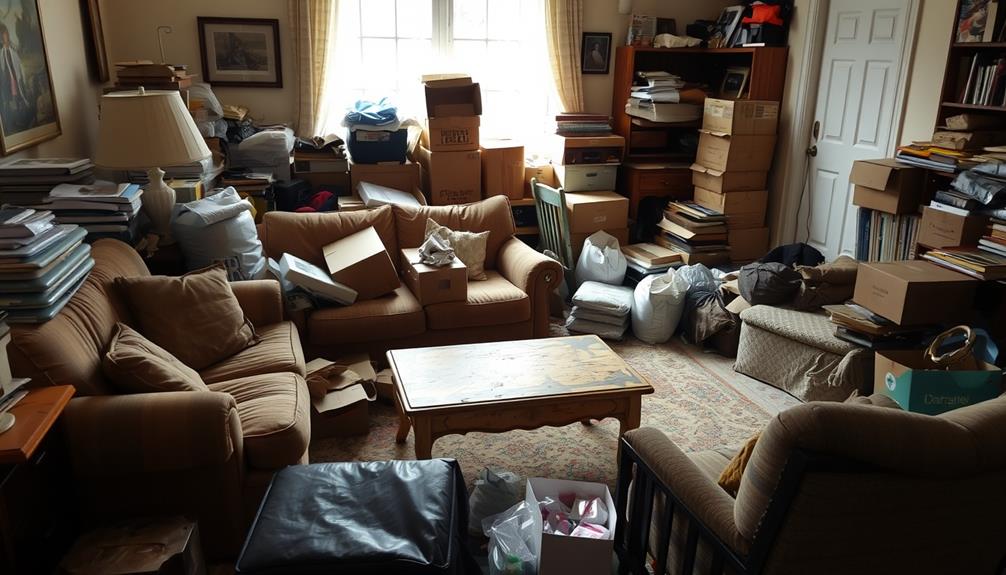Choosing the right palette involves understanding how colors affect mood and perception. Warm colors like reds and oranges energize and create cozy vibes, while cool shades like blues and greens promote relaxation. Light hues can make a space seem larger, and neutrals provide a versatile base. Accent colors add focal points, and balancing warm and cool tones ensures harmony. Keep exploring to discover how to craft a space that feels just right for you.
Key Takeaways
- Select colors that align with the room’s purpose: calming blues for bedrooms, energizing yellows for kitchens.
- Balance warm and cool tones to create harmony and influence the desired emotional atmosphere.
- Use light neutrals to make spaces appear larger and more open, while dark shades add intimacy.
- Incorporate accent colors strategically for visual interest and to highlight key design features.
- Consider lighting conditions, as they significantly affect how colors are perceived and the space’s overall mood.
The Basics of Color Psychology and Its Impact on Mood
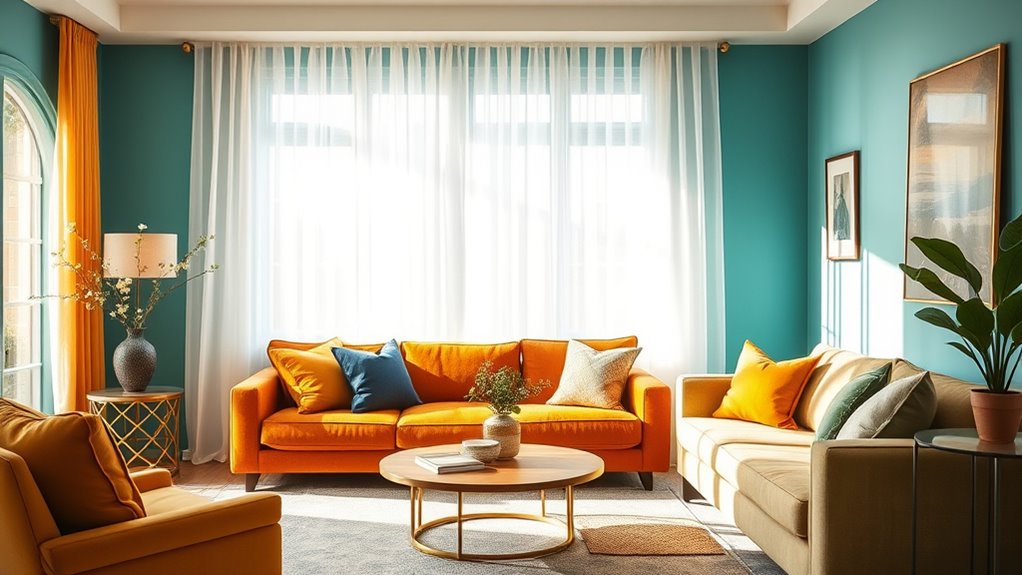
Color psychology explores how different hues influence our emotions and behaviors. When you choose colors for your space, you’re not just picking a pretty shade—you’re shaping the mood of the room. Bright colors like yellow can energize and uplift your spirits, making them perfect for lively areas. Calm colors like blue promote relaxation and focus, ideal for bedrooms or offices. Red can evoke excitement or passion, but too much might feel overwhelming. Green often brings balance and harmony, creating a soothing environment. Understanding these basic effects helps you select colors that align with your desired atmosphere. Additionally, incorporating essential oils into your space can further enhance the mood created by your color choices. Knowing how contrast ratios influence image quality can guide you in designing environments that feel more dynamic and engaging. Considering color harmony can help you create more cohesive and aesthetically pleasing designs. Using psychological color associations can help tailor your interior to evoke specific emotional responses, making your space more personalized. By intentionally choosing hues, you can influence how you feel in your space, making it more comfortable, motivating, or peaceful. Integrating knowledge about environmental considerations ensures your design choices support sustainability and well-being.
Understanding Warm and Cool Color Families
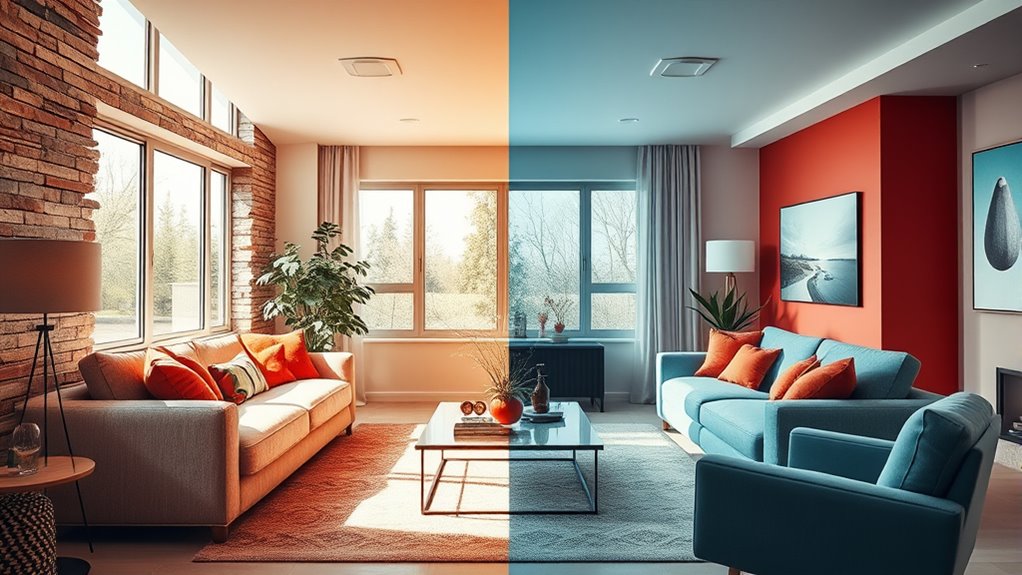
Warm colors like reds and oranges can energize a space and evoke feelings of enthusiasm, while cool tones such as blues and greens promote relaxation and calm. Understanding how these color families influence emotions helps you create balanced environments that suit your mood. Incorporating color psychology principles into your design can enhance the overall ambiance and emotional impact of your space. Additionally, being aware of potential emotional responses to different palettes allows for more intentional and effective interior design choices.
Warm Colors’ Emotional Impact
Since different hues evoke distinct emotional responses, understanding the emotional impact of warm colors is essential in interior design. Warm colors, such as reds, oranges, and yellows, tend to energize and stimulate. They evoke feelings of warmth, comfort, and enthusiasm, making spaces feel inviting and lively. Red can increase excitement and passion, perfect for focal points or social areas. Orange fosters friendliness and creativity, ideal for informal spaces. Yellow promotes optimism and happiness, brightening a room and boosting mood. Incorporating color psychology principles can help in selecting the most effective warm hues for specific environments. Additionally, understanding zodiac sign compatibility can inform the choice of colors that resonate with the emotional needs of the space’s occupants. The use of color harmony can further enhance the aesthetic appeal and emotional balance within a room. Using color contrast techniques can create visual interest and prevent overwhelming the space with too much warm hue. To maintain a balanced atmosphere, it is also helpful to consider color saturation to avoid overwhelming the senses. However, using too much warm color may feel overwhelming or aggressive, so balance is key. Incorporating warm hues thoughtfully can create a vibrant, welcoming atmosphere that energizes occupants and enhances the room’s overall mood.
Cool Colors’ Calming Effects
Cool colors, such as blues, greens, and purples, are known for their calming and soothing effects on a space and its occupants. These hues help create a tranquil environment, perfect for relaxation or focus. Blue, in particular, lowers stress and promotes feelings of peace, making it ideal for bedrooms and offices. Green encourages harmony and balance, offering a revitalizing vibe that can reduce anxiety. Purple, especially softer shades, inspires creativity and serenity. When you incorporate cool colors into your interior, you foster a sense of openness and calmness that can help ease tension. These shades work well in spaces where you want to promote relaxation, clarity, and mental calm. Using cool colors thoughtfully can transform your environment into a peaceful retreat. Being aware of color psychology can help you select palettes that enhance your desired mood and atmosphere. Additionally, understanding how interior color schemes influence emotions allows for a more intentional and effective design process, especially when considering psychological effects of color. Recognizing the impact of paint selection on mood can further refine your calming space, as it plays a crucial role in the overall well-being of the inhabitants.
Balancing Warm and Cool Tones
Understanding how to balance warm and cool tones is essential for creating a harmonious interior. Warm colors like reds, oranges, and yellows evoke energy and coziness, while cool colors such as blues, greens, and purples promote calmness. To visualize this balance, consider this table:
| Warm Tones | Neutral/Blended Tones | Cool Tones |
|---|---|---|
| Sunset Orange | Soft Beige | Mint Green |
| Deep Red | Light Gray | Sky Blue |
| Amber Yellow | Cream | Lavender |
Mixing these tones thoughtfully allows you to craft a space that feels lively yet relaxing. For instance, pairing warm accents with cool walls creates visual interest without overwhelming the senses. Striking this balance is key to a well-rounded, inviting environment. Additionally, understanding color psychology can help you choose tones that align with the mood you want to evoke in your space. Recognizing how color harmony functions can further enhance your interior design choices and create a more cohesive look. Incorporating color contrast techniques can also add depth and dimension to your design. Furthermore, experimenting with different color combinations can lead to unique and personalized interior aesthetics. Being aware of remote work benefits and challenges can also influence your choice of colors to promote productivity and well-being in your space.
How Color Choices Influence Perception of Space
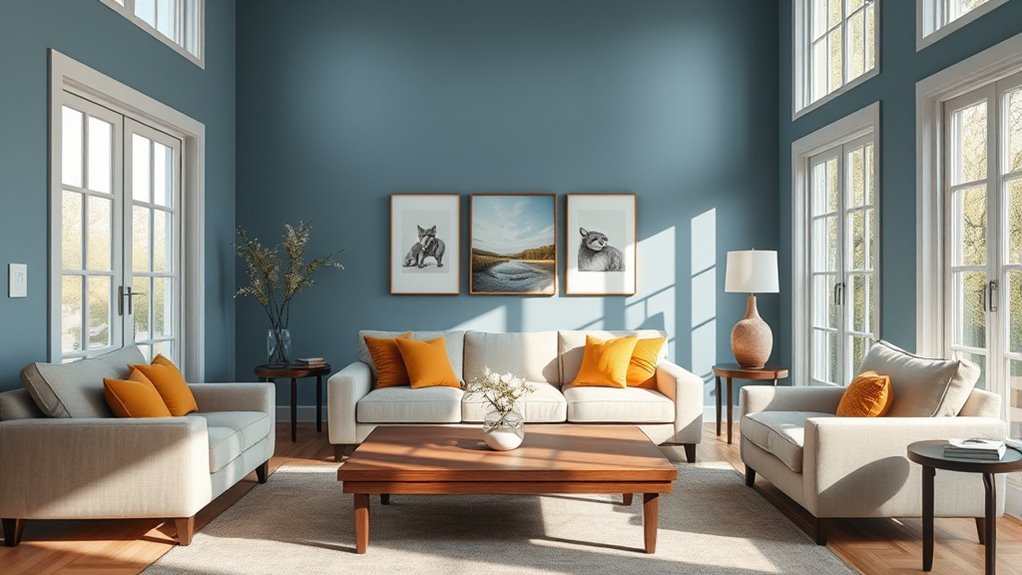
The colors you choose can make a room feel larger or smaller than it really is. Light shades tend to open up space, while darker hues can create a cozy, intimate atmosphere. Your color choices directly influence how you perceive the room’s size and the mood it sets. Incorporating color psychology principles can help you select the right palette to achieve your desired effect. Additionally, understanding how color contrast impacts visual perception can aid in creating a balanced and harmonious environment. Developing your creative practice by experimenting with different color combinations can further enhance your interior design skills and outcomes. Being aware of regional design trends can also inspire fresh ideas and keep your space current. Paying attention to lighting conditions can significantly alter how colors appear and influence the perceived size of the space.
Room Size Perception
Color choices can dramatically influence how spacious a room feels, often tricking the eye into perceiving more or less space than actually exists. Light, neutral colors like whites, beiges, or pastels reflect more light, making a room seem larger and more open. Darker shades absorb light, creating a cozy, compact feel. To visualize, consider this table:
| Color Shade | Effect on Space | Ideal Use |
|---|---|---|
| Light | Expands perceived size | Small rooms, ceilings, walls |
| Dark | Shrinks perceived size | Accent walls, cozy corners |
| Bright | Adds vibrancy, openness | Living areas, kitchens |
Choosing the right palette allows you to manipulate space perception, making your room feel airy or intimate based on your goals. Additionally, incorporating vertical storage solutions can enhance the sense of openness by keeping clutter out of sight and maintaining a clean visual flow.
Mood and Atmosphere
Color choices directly shape the mood and atmosphere of a space, influencing how you perceive and feel within it. Bright, warm hues like yellows and reds energize and create a lively, welcoming vibe, perfect for social areas. Cool shades such as blues and greens evoke calmness and serenity, making spaces feel peaceful and relaxing. Dark colors like charcoal or navy add sophistication and intimacy but can also make a room seem smaller or more enclosed. Light, neutral tones foster openness and cleanliness, boosting brightness and spaciousness. Your color selections can transform a room’s emotional tone, whether you want to energize, soothe, or create intimacy. By understanding these effects, you can choose a palette that aligns with the mood you want to evoke in your space.
Selecting Colors for Different Rooms and Functions
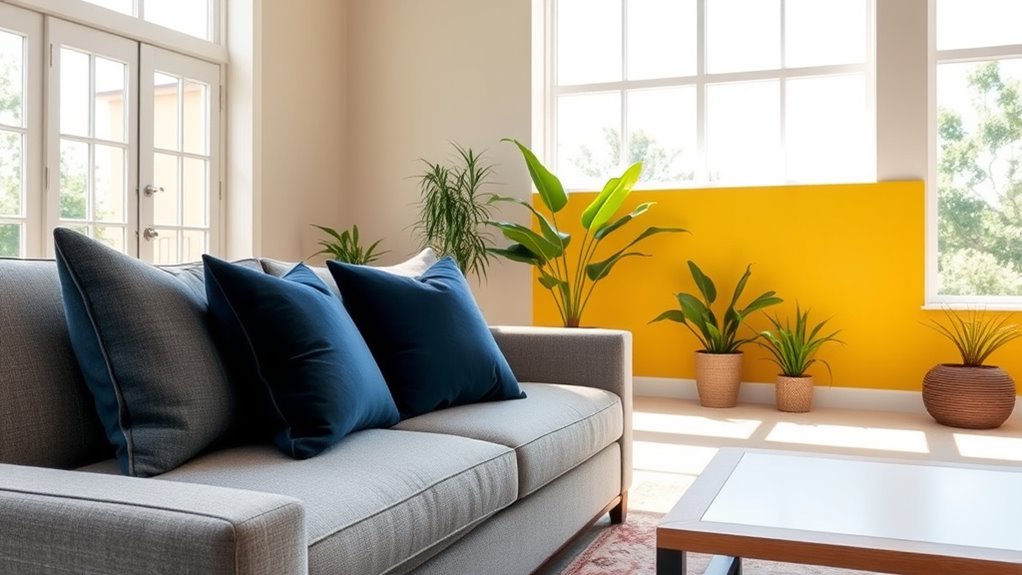
Choosing the right hues for different rooms can profoundly influence their purpose and how you feel in them. For a calming bedroom, opt for soft blues, gentle greens, or warm neutrals that promote relaxation. Kitchens benefit from lively, energizing colors like yellows or cheerful oranges that stimulate appetite and conversation. In a home office, choose shades like muted blues or grays to foster focus and productivity. Living rooms can handle warm tones such as terracotta or rich browns, creating inviting spaces for socializing. Bathrooms often work well with light blues, seafoam greens, or crisp whites, which evoke cleanliness and tranquility. Always consider the room’s function when selecting colors, ensuring they support the mood and activities you associate with each space.
Balancing Color Schemes for Harmony and Energy
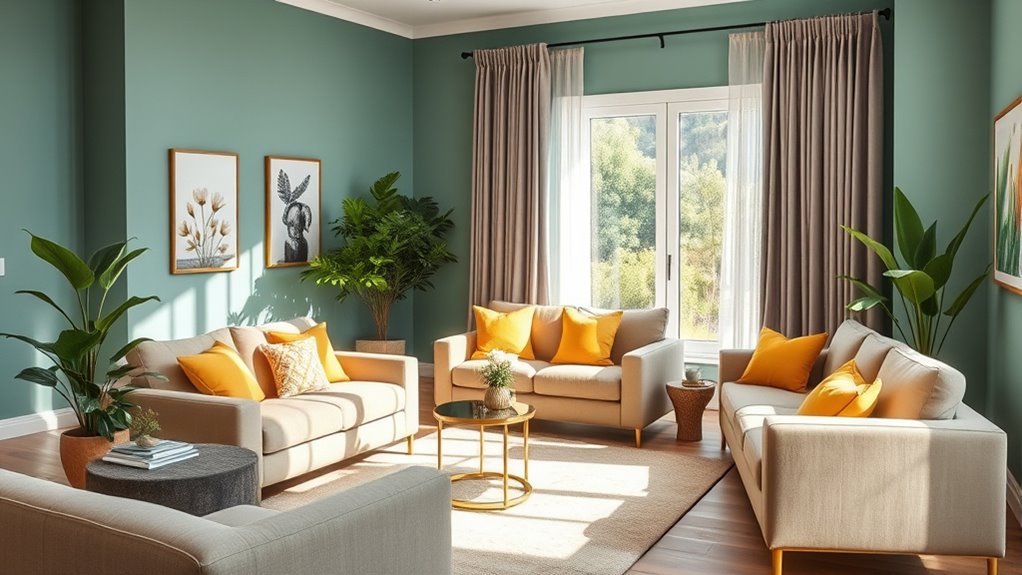
Achieving a harmonious balance between colors in your interior design can create spaces that feel both lively and cohesive. To do this, combine bold hues with more subdued tones to prevent overstimulation while maintaining energy. Use the color wheel to identify complementary colors that enhance each other without clashing. Incorporate accent walls or accessories in vibrant shades to add excitement without overwhelming the room. Keep the overall palette consistent by repeating key colors throughout the space, which helps unify different areas. Pay attention to color proportions: large areas should feature calmer shades, while smaller elements can carry more intense hues. This balance ensures your space feels vibrant yet organized, fostering a welcoming environment that energizes without chaos.
The Role of Neutral Tones in Interior Design

Neutral tones play a crucial role in creating balanced and versatile interior spaces. They serve as a foundation that allows other colors and design elements to stand out without overwhelming the room. When you incorporate neutrals like beige, gray, or taupe, you create a calm, sophisticated atmosphere that appeals to a wide range of tastes. These tones also help to make a space feel more open and airy, especially when paired with good lighting. Neutral palettes are flexible; you can easily change accents and accessories to refresh the look without redecorating entirely. By using neutral tones strategically, you establish a timeless backdrop that enhances the overall harmony of your space, offering a sense of tranquility and cohesion.
Incorporating Accent Colors to Create Focal Points
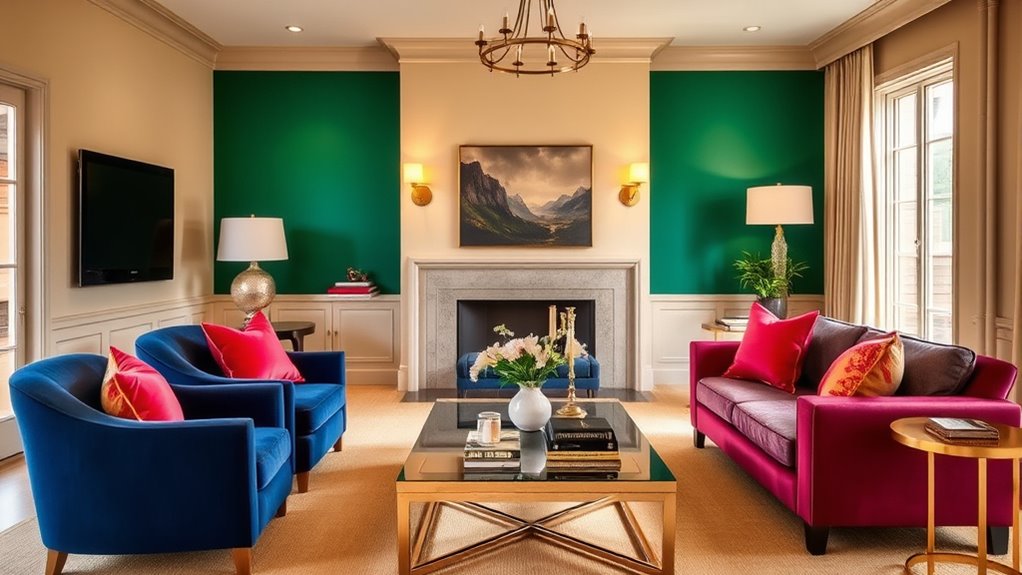
Incorporating accent colors is an effective way to draw attention and establish focal points within your interior space. By choosing bold or contrasting hues, you can highlight specific areas or features, making your room more dynamic. For example, add a vibrant throw pillow to a neutral sofa or paint a single wall a striking color. These small but impactful choices can guide the eye and create visual interest. To maximize their effect, consider:
Accent colors add visual interest and highlight key features in your space.
- Using accent colors on architectural features like moldings or door frames
- Adding colorful accessories such as vases, artwork, or rugs
- Painting a statement wall that naturally draws attention
Tips for Testing and Implementing Your Color Palette
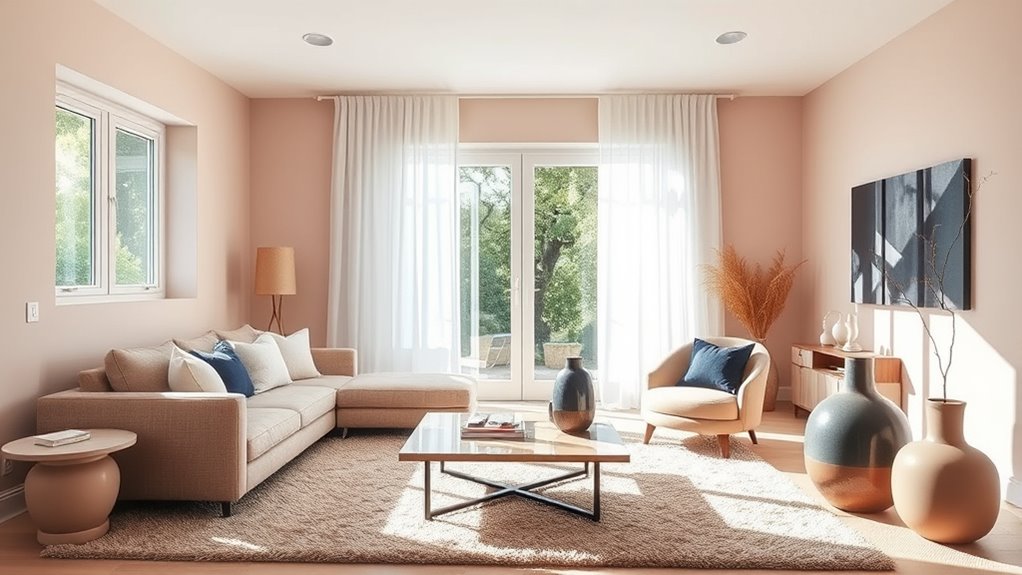
Before settling on your final color choices, it’s essential to test and see how they look in your space. Start by applying sample swatches or paint patches on your walls to observe how the colors interact with natural and artificial light throughout the day. Use large fabric samples or digital renderings to visualize how different shades complement your furniture and decor. Don’t rush the process—spend time living with the samples to see how they feel in different settings. When ready to implement, paint a small section or create a temporary accent wall to ensure the color works well. This approach helps prevent costly mistakes and guarantees your chosen palette creates the desired mood and harmony in your space.
Frequently Asked Questions
How Do Cultural Differences Affect Color Psychology in Interior Design?
Cultural differences considerably influence how you perceive colors in interior design. What feels calming in one culture might be associated with mourning in another. For example, white symbolizes purity in some countries, but mourning in others. You should consider your audience’s cultural background when selecting colors to guarantee your space feels welcoming and meaningful. Being mindful of these differences helps you create a space that resonates positively with everyone who enters.
Can Lighting Changes Alter the Perceived Mood of a Color Palette?
Think of lighting as the sun’s gentle touch on a painting, transforming its essence. You can substantially alter how a color palette’s mood feels by adjusting lighting. Warm lighting creates coziness and intimacy, while cool lighting promotes calmness and clarity. Even subtle changes can evoke different emotions, making your space versatile. You hold the power to shift perceptions, turning a room into a sanctuary or a lively gathering spot, simply through light.
How Do Trends Influence the Longevity of Color Choices in Interiors?
You should consider how trends impact the longevity of your interior color choices. Trends often come and go, making bold or trendy colors feel outdated quickly. To guarantee your space remains timeless, opt for classic hues that won’t fall out of favor, and incorporate trendy accents through accessories or artwork. This way, you enjoy current style without sacrificing long-term appeal, keeping your space fresh and relevant for years.
What Are the Best Tools for Visualizing Color Schemes Before Implementation?
Did you know 85% of homeowners say visualizing their color schemes beforehand helps prevent costly mistakes? When choosing tools, you should use digital apps like Sherwin-Williams ColorSnap or Benjamin Moore’s Personal Color Viewer. These let you upload photos and experiment with palettes instantly. You can see real-time results, ensuring your color choices match your vision before committing. This saves time, money, and boosts confidence in your interior design.
How Do Color Preferences Vary Across Different Age Groups?
You’ll notice that age influences color preferences markedly. Younger individuals often favor bright, bold hues that evoke energy and excitement. Middle-aged people might prefer more subdued, sophisticated tones for a calming atmosphere. Older adults tend to favor softer, pastel shades that promote comfort and relaxation. Understanding these trends helps you choose colors that resonate with specific age groups, creating spaces that feel personalized and inviting for everyone.
Conclusion
Remember, your color choices shape how you feel and perceive your space—it’s no coincidence. By understanding color psychology and thoughtfully selecting palettes, you create a home that aligns with your mood and needs. Sometimes, the perfect hue just appears when you least expect it, reminding you that trust in your instincts and the process can lead to a beautifully balanced environment. After all, your space should reflect your unique personality—so let colors surprise you.


